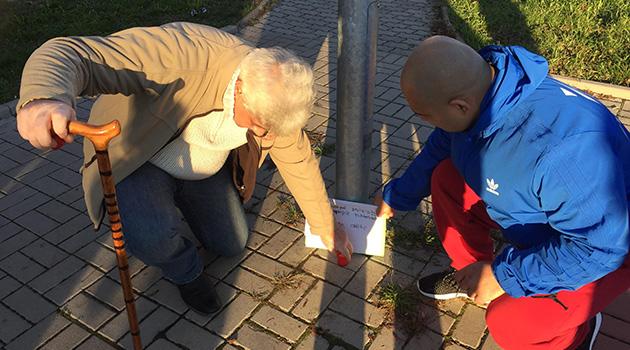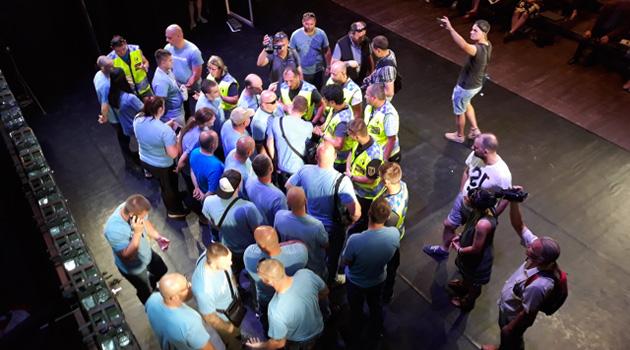Residents of the Czech Republic's "Wild North" choose between nostalgic vigilantism and forward-looking coexistence

Anybody who could do so moved away from the Janov housing estate in the northern Bohemian town of Litvínov long ago. The only people still living there now are those who have nowhere else to go.
Janov is, at first glance, a ghetto, and one of the worst in the northern Czech lands. It is exactly this region that the investigative website HlídacíPes.org has chosen to report on as an example of the deep divisions in Czech society, and this piece was recently published by them in five Central European countries along with other examples of contemporary societal polarization.
Today just a few ruined buildings remain standing on the socialist-era housing estate. Janov has become a symbol of social exclusion – but also of hope that social work projects will aid the situation and that at least some of the buildings can manage to be saved.
Many properties there will be mercilessly razed to the ground within the next three years. Janov is also a reminder of the social unrest that has afflicted northern Bohemia in recent years.
November 2018 marked the 10th anniversary of one of the most serious clashes ever to transpire between police and right-wing radicals in the Czech Republic, when the radicals attempting a pogrom at Janov against its Romani residents. That was the beginning of a very harsh phase of anti-Romani marches in northern Bohemia that culminated three years later in the Šluknov foothills region and the many such marches undertaken there.
When the “decent” Czechs join in
The right-wing extremists returned to Janov to mark the 10-year anniversary of their failed attempt. The Workers Social Justice Party (DSSS) organized a commemoration of the events.
In 2008, police prevented what was the most forceful ever modern-day attempt at an anti-Romani pogrom in the country. Hundreds of right-wing extremists and their followers first demonstrated against Romani people in the center of Litvínov before clashing with police while attempting to march on Janov.
Cobblestones and tear gas grenades flew through the air during the street violence. An armored personnel carrier with a water cannon, mounted police, and riot units kept the right-wing extremists out of Janov in 2008.
Three years later, in the Šluknov foothills, the situation was somewhat different. National-level politicians who did not yet have even a general idea of what such anti-Romani pogroms entail were suddenly surprised by the force of the demonstrations – above all, by the fact that more people than just extremists were contributing to them.
The events began when machete-wielding Romani people assaulted the customers of a gaming room in the town of Nový Bor. A security camera captured the attack by about 20 Romani people, including audio from the aftermath of one of them saying “We really gave it to those white heads”.
The subsequent wave of demonstrations against Romani people in the town of Varnsdorf and its surrounding areas at the close of August and start of September was surprising in its strength. Politicians from Prague finally visited northern Bohemia, something municipal representatives had been asking them to do for some time.
As is customary in the case of such politicians, however, they came and then left, giving a couple of interviews to the media, but not much changed in reality. The single visible consequence of the explosion of social tensions was the establishment of permanent police riot units headquartered in Ústí nad Labem.
The people who had been complaining about the social problems that were not being solved remained abandoned for quite some time. They began to address the situation as they saw fit – and it’s true that they frequently chose somewhat odd methods.
We will defend our homeland
A rather widespread cliché currently exists in the Czech discussion according to which anti-Romani sentiment has, in recent years, been replaced by an irrational reaction to the migration crisis. In Czech conditions this response is irrational because the country was spared the impacts of that crisis and remains one of the safest countries in Europe.
Anti-immigrant sentiment here is blown out of proportion by right-wing extremists recruiting from the same groups that contributed to unleashing the events in northern Bohemia we have mentioned above. The victims of this propaganda are people who subsequently, in their isolation, find the solution to be that of taking the course of events into their own hands.
These include small groups such as the so-called National Militia (Národní domobrana) of which there are currently about 60 in the Czech Republic. We are describing them as small because the numbers involved in each group are low.
These groups go on foot to “watch over” the so-called “green border” and the Ore Mountains (Krušné hory) on the Czech-German border. They are not dangerous, work within legal limits, and have no powers.
On the other hand, these groups apparently represent connections between former border guards, members of the “Freedom and Direct Democracy of Tomio Okamura” (SPD) party, which is seated in Parliament, and nationalists. Moreover, they include pro-Russian groups such as the so-called “Consulate of Donetsk”, led by a boss of the National Militia, Nela Lisková.
In practice, their patrols look like this: A Renault station wagon is parked across a road as a vehicular blockade. Standing near it is Mr Jiří Kajman Zícha with his German shepherd and Hussite banner.
It is 12 June 2017, and this location was once the Petrovice border checkpoint in the Ústecký Region. The first National Militia “Ore Dogs” patrol has taken to the field.
“Today we must be visible. The time will come when we will become the border,” Zícha screams on Facebook.
Is this just a game? Or is this attempt to form civic patrols comprised of such former border guards meant seriously?
Hus + Zeman + Žižka
The Facebook profiles of the National Militia and its supporters from the regions are the usual mix of content shared from pro-Russian websites, expressions of support for Czech President Miloš Zeman, and references to figures from Bohemian history such as the martyred 15th-century religious reformer Jan Hus or the medieval general Jan Žižka. However, they also post information about their own activities.
“Soldiers, militias, join us, it’s better to be prepared. We need to deploy to these sections: Cínovec-Fláje and Petrovice-Děčín, to do random checks of the green border for now,” reads a post on one of the militia’s profiles.
The aim is to post interconnected militias to the former checkpoints of what was once the border between communist Czechoslovakia and communist East Germany. The activity of communist-era border guards who have sensed a chance to redeploy is apparent here.
As František Fanda Kanga, a former member of the Czechoslovak Border Guard, writes online: “Each company of the Border Guard had its own name: The Moldava Tigers, the Cínovec Polecats, the Habartice Eagles, the Krásnoleský Goats. That’s how it went on down to Hrádek nad Nisou, where the Děčín Brigade of the Border Guard stopped.”
Recently the patrols have also been setting out for the German side of the border. Once again: While they have zero authorization, they also have big expectations.
“On the German side the population was extremely helpful. They even respected us,” the Litvínov militia praised themselves after one such trip to the village across from Český Jiřetín on the German side.
A clear, patriotic conscience
Against whom, in fact, are these militias patrolling? The purpose of such actions, in a situation where the number of migrants illegally crossing the “green border” has fallen to a minimum, is unclear.
Are the patrols meant to prevent people crossing the border from the Czech Republic into Germany? Or to stop those who might eventually return from there to the Czech Republic?
HlídacíPes.org asked representatives of these militias for an interview. “A personal meeting would be best, it’s not possible to just briefly describe everything. There could be a lack of comprehension, a misunderstanding. Otherwise we have nothing to hide, our patriotic conscience is clear,” Zícha – the man with the Renault described above – writes back when we approach him.
Several days later, the details are arranged. “If you will be interested in coming and getting unbiased information about the activities of the Militia group, I will give you as much time as you need in the interest of the truth. These are complex, important matters that can’t be addressed by answering in a few words on Facebook. Thanks for your understanding, I am ready to discuss anything with you. Jiří Kajman Zícha, in Dubí,” he writes.
Ultimately, however, there is no meeting. “Hello. A meeting is no longer possible, please contact František Krejča, Council of the National Militia,” Zícha writes.
Krejča is one of three leaders of the National Militia. None of them responds to our editor’s requests – the militia members are not interested in publicity.
Coming home to Janov
Naturally, there are other ways to approach the situation in the north. Petr Globočník (age 36) is a Green Party politician, an opposition local assembly member in Litvínov representing the group “Litvínov do toho!” (“Go, Litvínov!”).
He, too, calls himself a north Bohemian patriot. He grew up at Janov and lived there until the age of 21.
Globočník recalls the days when the prefabricated apartment buildings were not yet ruins at risk of being razed to the ground. That is the plan adopted for them by the Litvínov city council, to be implemented by 2022.
“We want to demolish the prefabricated apartment buildings at Janov that we have already bought out, the ones that have been subjected to wear and tear. It’s four buildings with as many as 500 units,” Vice Mayor Erika Sedláčková (Communist Party of Bohemia and Moravia – KSČM) recently said.
This locality with its uncertain future, which is being abandoned by anybody who can possible leave is, according to Globočník, an opportunity. For that reason, after last year’s autumn elections, when he took his seat on the local assembly he announced he was returning to live in his childhood neighborhood.
This is said to be a labor of love for him. “I think Janov cannot be saved as a whole. However, it certainly can be preserved in some smaller form,” he says.
Globočník’s group is proposing, for example, that the city continue to buy out properties on the estate. However, not all of them are to be slated for demolition – some are to be reconstructed and made further use of as part of so-called phased housing for residents who will be vetted to be impeccable.
“I want to be part of that,” says the social worker who has come home to Janov. The place where the passions of dissatisfaction with the social situation in northern Bohemia erupted a decade ago may have a chance yet.
First published on news server HlidaciPes.org.
